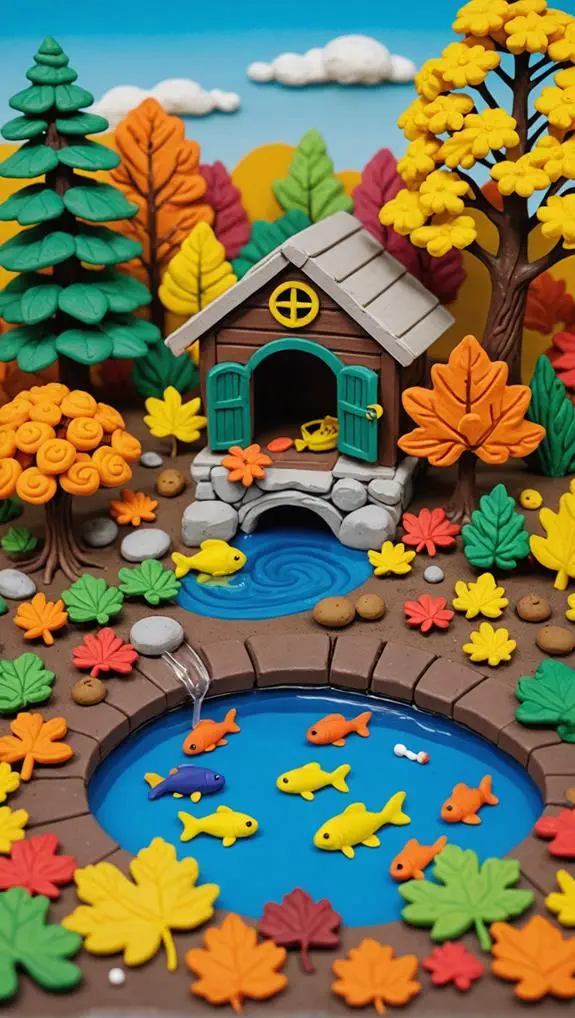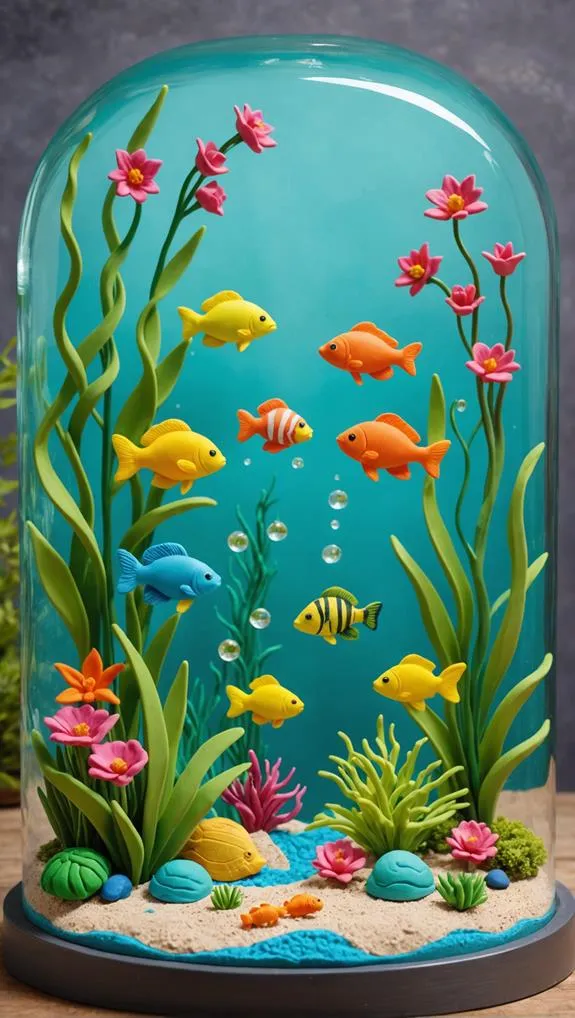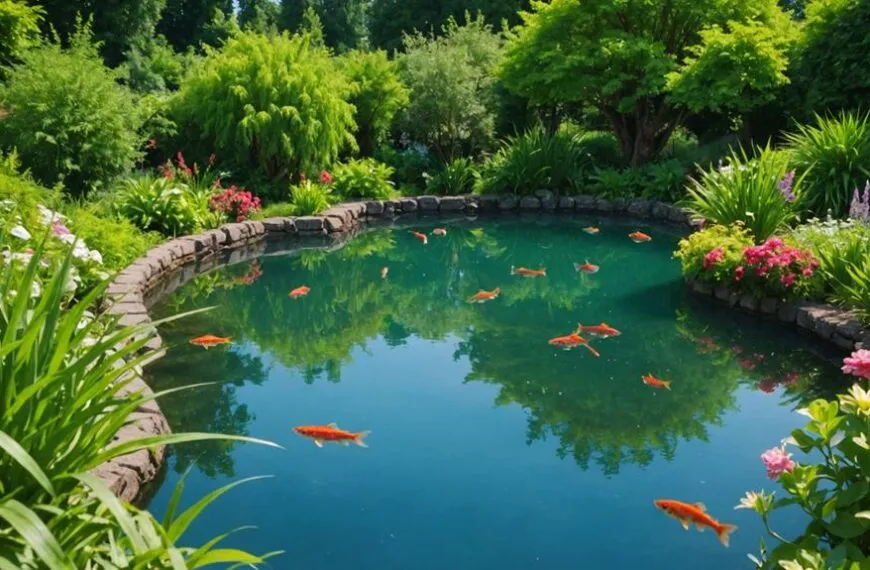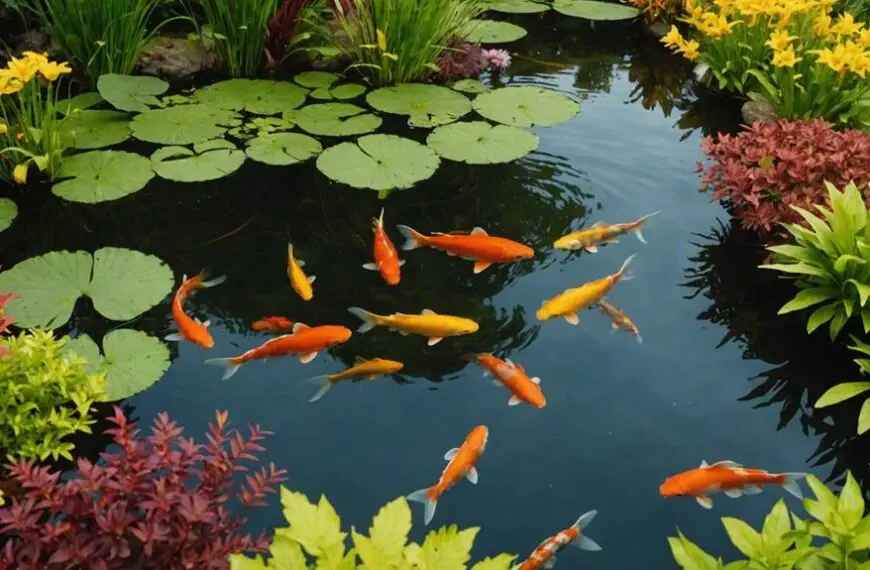To keep your fish healthy through seasonal changes, you'll need to make a few adjustments. In summer, maintain a comfy water temp (75-80°F) and boost aeration to keep oxygen levels high. During autumn, check your heater and change water regularly. Winter calls for limited water changes to avoid thermal shock, and make sure that heater's working since no one likes chilly fish! Come spring, clean your tank and inspect all equipment to ensure smooth sailing. Trust me; your fish will appreciate the effort, and you'll discover even more handy tips along the way!
Contents
Importance of Seasonal Fish Care
When it comes to keeping your fish healthy, you can't overlook the importance of seasonal care. Different seasons bring unique challenges and opportunities for your aquatic friends. For instance, temperature changes can greatly affect your fish species' health, so it's vital to monitor those water parameters closely.
In the warmer months, fish are particularly sensitive to low oxygen levels because higher temperatures reduce dissolved oxygen in the water, which can lead to lower oxygen levels and stress among fish. To combat this, you'll want to increase aeration and commit to regular water changes.
As fall approaches, it's crucial to check your heaters. Ensuring stable temperatures helps prevent stress and illness as the weather cools.
Winter care requires a bit more finesse; limit water changes to half the tank volume to avoid shocking your fish with cold water. And don't forget to keep an eye on your heater's functionality!
When spring rolls around, it's time for some deep cleaning and equipment maintenance. This prepares your tank for increased fish activity and potential breeding spurred by rising temperatures.
Summer Care Strategies
During summer, maintaining the right conditions for your fish is crucial to their health and well-being. As temperatures rise, aim to keep the water temperature between 75-80°F. You can use fans or chillers to help prevent overheating and keep your aquarium fish comfortable.
Increasing the frequency of water changes is also a smart move to combat rising temperatures and improve water quality, especially since high heat can lead to a buildup of harmful substances like ammonia, which should always be at 0 ppm for safe fish environments.
Don't forget about oxygen! Warmer water holds less dissolved oxygen, so enhancing aeration with air stones or increasing surface agitation can make a big difference. This'll help keep your fish happy and active.
Plus, when it comes to feeding, try providing smaller, more frequent meals to avoid excess waste and oxygen depletion.
Keep an eye on your fish for any signs of heat stress, like lethargy or gasping at the surface. If you notice these behaviors, it's time to adjust the temperature or boost oxygen levels.
Autumn Preparation Tips

As autumn rolls in, it's time to give your aquarium a little TLC to keep your fish happy and healthy.
Start by checking all your equipment, especially the heater—because nobody wants a surprise cold snap!
Regular water changes and monitoring water parameters are crucial during this transition, as they help maintain quality and reduce stress for your fish.
With shorter days ahead, adjusting the light and doing some partial water changes will help your fish transition smoothly into winter.
Equipment Check Essentials
Regularly checking your aquarium equipment is crucial for keeping your fish healthy, especially as autumn brings temperature fluctuations.
You want to ensure your heater's working properly, as those chilly nights can drop the temperature in your tank. Test it out and make sure it's ready for action!
Also, don't forget about your filter media. Cleaning or replacing it helps maintain optimal filtration efficiency, keeping water quality high and dissolved oxygen levels where they need to be.
While you're at it, check those automated systems like timers for lighting. With shorter days, your fish still need a proper sleep cycle, just like us!
Air pumps and airstones need a little love too; cooler temps can affect oxygen levels, so make sure they're functioning well.
Seasonal Health Preparations
With autumn's arrival, it's essential to prepare your aquarium for the seasonal changes ahead. As the weather cools down, your fish will need a little extra care to stay healthy and happy. Here are some best practices to consider:
- Inspect all aquarium equipment for functionality.
- Monitor and stabilize water temperatures to prevent stress.
- Gradually reduce light duration to mimic shorter autumn days.
- Conduct health checks on your fish for any signs of illness.
- Ensure essential equipment like filters and heaters are running smoothly.
Taking these steps will help keep your fish comfortable as the seasons shift. Start by checking your heaters; cooler temperatures can lead to heater failures, so make sure everything's working properly.
Next, keep an eye on water temperatures to avoid sudden drops that could stress your fish. Transitioning the lighting gradually will help your aquatic friends adapt to the shorter days, while regular health checks allow you to catch any issues early on.
Lastly, maintaining your equipment ensures a healthy environment as winter approaches. By following these tips, you'll be setting your fish up for success during autumn and beyond!
Winterization Strategies
Preparing your aquarium for winter is crucial for maintaining a healthy environment for your fish.
First things first, check your heater! A reliable heater keeps the water warm and stable, preventing stress and illness. You wouldn't want your fish to feel like they're in an ice bath, right?
Next, take a good look at your lighting systems. Gradually reduce the light duration to mimic the shorter days of autumn. This helps your fish adjust and keeps their natural cycles in check.
Don't forget those water changes! Limit them to no more than half of the tank volume at a time. This helps avoid shocking your fish with sudden temperature changes—nobody likes a surprise party when it's freezing outside!
Winter Health Management
As winter sets in, keeping a close eye on your fish's health becomes crucial, since colder temperatures can heighten their vulnerability to diseases. During this season, you want to ensure they thrive, not just survive.
Here are some essential tips to help you manage their health effectively:
- Regularly monitor water temperature.
- Limit water changes to 50% to prevent thermal shock.
- Check and maintain the heater's functionality.
- Inspect fish for signs of illness or stress.
- Be mindful of indoor heating effects on humidity.
With lower water temperatures, your fish's metabolism slows, making symptoms of illness harder to spot.
Keep your heater in check to maintain a higher temperature, ideally between 74°F to 78°F. When changing your aquarium water, make sure it's close to the existing temperature to avoid shocking them.
If evaporation rates increase, consider more frequent water changes to maintain quality.
Spring Maintenance Practices

As spring rolls in, it's time to give your fish tank some much-needed TLC!
You'll want to check your equipment, monitor water quality, and maybe even spruce things up a bit for your underwater friends.
Think of it as spring cleaning for your tank—because who doesn't love a fresh start, right?
Equipment Check and Maintenance
With spring just around the corner, it's time to focus on your aquarium's equipment check and maintenance. As the weather warms, your aquatic pets will be more active, making it essential to ensure everything is running smoothly.
Here's a quick checklist to guide you through this important task:
- Inspect and clean all filters and heaters.
- Replace or clean filter media to prevent ammonia build-up.
- Test your heater for the ideal temperature range of 75-80°F.
- Check electrical equipment for frayed wires and wear.
- Document maintenance tasks to spot patterns for next year.
Taking care of your equipment is crucial for maintaining water quality and ensuring your fish stay healthy. A clean filter and a reliable heater can make all the difference in keeping your aquatic pets happy.
Don't forget to take a moment to enjoy the process; it's a great way to connect with your tank buddies!
Water Quality Monitoring
Maintaining optimal water quality is crucial for your fish's health, especially during the spring when temperatures rise and aquatic life becomes more active. You'll want to dive into water quality monitoring, checking parameters like pH, ammonia, nitrite, nitrate, and hardness at least once a week.
As warmer weather can quickly alter conditions, staying on top of these tests is essential for your fish's survival rates.
Don't forget about frequent water changes! Aim for 20-30% of your tank to be replaced regularly. This helps dilute any toxins that may have built up, promoting a healthier natural environment for your aquatic friends.
Spring can also bring an unwelcome boost in algae growth. Keep an eye on nitrate levels and consider adding some plants that will outcompete algae for nutrients, keeping your tank looking spiffy.
Lastly, ensure the water temperature stays between 75-80°F. Adjust your heater as needed to prevent stress on your fish.
Aesthetic Enhancements and Care
After ensuring your fish are thriving in a well-maintained environment, it's time to focus on enhancing the aesthetic appeal of your aquarium. Spring is the perfect season to refresh your setup and make it a vibrant home for your aquatic friends.
Here are some ideas for aesthetic enhancements:
- Add seasonal decorations to reflect the beauty of spring.
- Introduce live plants to create a lively, natural habitat.
- Rearrange existing decor for a fresh look and feel.
- Install colorful LED lights to highlight your aquatic scenery.
- Consider a new background to give your aquarium a stunning new vibe.
As the water warms up, your fish become more active, so it's a great time to perform a thorough cleaning. Vacuum the substrate, clean decorations, and conduct a partial water change to boost water levels and quality.
Don't forget to check your heater and filter! Keeping an eye on water parameters is crucial, too.
Plus, increase their feeding frequency and variety to keep them energized. With these steps, you'll not only enhance the visual appeal but support your fish's health and happiness as well!
General Tips for All Seasons
To keep your fish healthy throughout the year, it's essential to establish a consistent routine for maintenance tasks.
Make frequent water changes a priority, as they create a clean environment that helps your fish thrive. Don't forget to vacuum the substrate regularly to remove debris and waste—think of it as giving your tank a little spring cleaning!
Daily monitoring of your fish's behavior is crucial. Keep an eye out for any signs of stress or illness, like changes in appetite or unusual swimming patterns. Catching these issues early can make a world of difference.
As the seasons change, so do water parameters. Adjust your feeding schedules and water quality checks accordingly. For instance, during cooler months, fish may need less food.
Engaging with local aquarist groups or online forums can also be a game-changer. Sharing knowledge is a great way to learn new tips and tricks for keeping your aquatic friends happy.
Frequently Asked Questions
How Do You Make Water Changes Less Stressful for Fish?
To make water changes less stressful for fish, use acclimation techniques by matching water temperature, perform regular filter maintenance, and gradually introduce new water to ensure stress reduction and maintain a stable environment for your fish.
How Do You Take Care of Fish While on Vacation?
Before you jet off, think of your fish like treasured guests. Prepare their tank with a thorough cleaning, ensure water quality's spot-on, set up automatic feeders, and check your vacation checklist for peace of mind.
How to Care for Fish in Summer Season?
During summer, you've got to manage temperature carefully, adjust summer feeding practices, ensure pond safety, and control algae growth. Keeping your fish comfortable and healthy requires daily monitoring and proactive steps to prevent stress and illness.
How Can I Keep My Fish Healthy?
To keep your fish healthy, ensure proper aquarium lighting, monitor temperature control, and perform regular tank maintenance. Feed them quality fish food, adjusting types as needed, to promote vitality and a thriving environment.
Final Thoughts
Keeping your fish healthy through seasonal changes is like preparing for a wild rollercoaster ride—exciting, a bit daunting, but oh-so-rewarding! By following the tips for each season, you'll ensure your finned friends thrive and maybe even dance a little in their water. Remember, a happy fish is a healthy fish! So, dive in, stay attentive, and don't forget to enjoy the joy of watching them splash around, because their happiness makes your world a little brighter!












